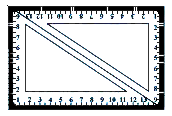Complete Solutions to TRY THIS of chapter QUADRILATERALS of Class 7 book with complete answers and questions
| Class 7 | MATHS |
| Chapter | QUADRILATERALS |
| TELANGANA | TRY THIS |
| Number Of Questions | 15 |
| Academic Year | 2023-24 |
How many different quadrilaterals can be obtained from the adjacent figure? Name them.

View Solution
Z is
View SolutionWhat would happen if the quadrilateral is not convex? Consider quadrilateral ABCD. Split it into two triangles and find the sum of the interior angles. What is the sum of interior angles of a concave quadrilateral?

View SolutionProve that in a kite ABCD `Delta ABC and Delta ADC` are congruent.

View SolutionTake two identical set squares with angles `30^(@) – 60^(@) – 90^(@) `and place them adjacently as shown in the adjacent figure. Does this help you to verify the above property? Can we say every rectangle is a parallelogram?

View SolutionTake two identical `30^(@) – 60^(@) – 90^(@)` set squares and form a parallelogram as before. Does the figure obtained help you confirm the above property?
View SolutionIn the below parallogram find `/_I` and `/_G` by any other method? (hint: angle-sum property of a quadrilateral)

View SolutionHow many different quadrilaterals can be obtained from the adjacent figure? Name them.

View Solution
(i) Is quadrilateral EFGH a convex quadrilateral?
(ii) Is quadrilateral TUVW a concave quadrilateral?
(iii) Draw both the diagonals for quadrilateral EFGH. Do they intersect each other?
(iv) Draw both the diagonals for quadrilateral TUVW. Do they intersect each other?
View SolutionWhat would happen if the quadrilateral is not convex? Consider quadrilateral ABCD. Split it into two triangles and find the sum of the interior angles. What is the sum of interior angles of a concave quadrilateral?

View SolutionProve that in a kite ABCD, `DeltaABC` and `DeltaADC` are congruent.

View SolutionTake two identical set squares with angles `30^(@) – 60^(@) – 90^(@) `and place them adjacently as shown in the adjacent figure. Does this help you to verify the above property? Can we say every rectangle is a parallelogram?

View SolutionTake two identical `30^(@) – 60^(@) – 90^(@)` set squares and form a parallelogram as before. Does the figure obtained help you confirm the above property?
View SolutionIdentify two or more pairs of supplementary angles from the parallelogram ABCD given above.
View SolutionIn the below parallogram find `/_I` and `/_G` by any other method? (hint: angle-sum property of a quadrilateral)

View Solution
TRY THIS questions and complete solutions for chapter QUADRILATERALS of NCERT Maths(TELUGU) of Class 7